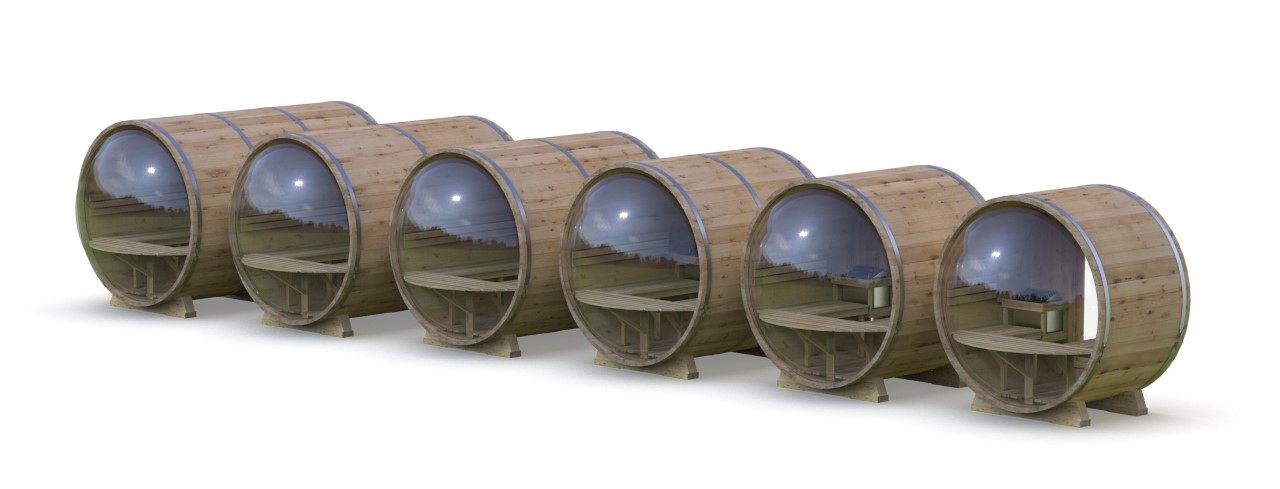Montreal Saunas Inc.
Need Help
Frequently Asked Questions
__________
The intake air vent of a sauna barrel using an electric heater should be located under the heater. The out-air vent or exhaust vent should be installed higher up, so that there is slow moving air circulation, this will allow the heater to work more efficiently. The gap underneath or around the Sauna door most often is adequate for this purpose. The traditional method of venting has been to take the air in down below, underneath the stove, and let it out near the ceiling using a controlled air vent. You should be able to open or close half way for it to be efficient. This type of ventilation “underneath the stove” only works well when the unit is hot and will provide fresh breathing oxygen for the people inside the barrel.
Understanding that “hot air rises”, you will understand that the flow of air in a barrel sauna will be taking the lower-level cooler air from the floor, passing it through the hot heater to create air circulation. A good ventilation system will improve your sauna experience by shortening the warm up times, and giving the sauna heater a constant exchange of air. This heat circulation, called a convection current, is more efficient at circulating air within the sauna due to the round shape of the barrel and will keep the inside at a more uniform temperature.
__________
Sauna is the Finnish word for “bath.” Finns who immigrated to North America brought with them a unique bathing custom, which has become popular here over the past decade. Often confused with a steam bath, a true sauna bath is very different, even though both types of baths offer the same therapeutic benefits.
The temperatures in a traditional sauna can actually exceed 90 degrees Celsius! The extremely low humidity present in the sauna makes these temperatures tolerable. Properly designed, the sauna’s relative humidity rarely exceeds 5% when operated in the “dry” mode. This permits the copious amount of perspiration produced by the body to dry quickly thus having a cooling effect.
Most saunas (except the newer infrared ceramic emitters which I will get to later) have a radiant air heater, which has a tray for volcanic stones. These stones retain and radiate heat more consistently. They may also be sprinkled with water to produce the “wet” sauna. This creates bursts of steam, which disappear quickly into the porous cedar of the sauna. Humidity climbs from a few percent to 20-30% instantly. This intensifies the sauna’s heat as if the temperature had increased drastically (although it may even have dropped slightly).
By contrast, a steam bath makes use of a steam generator. This device heats the water, not the air. The steam room enclosure fills completely with condensed vapor. Clouds of “steam” envelop the bather. The humidity exceeds 100% and the temperatures are much lower than those of the sauna. Because of their very different modes of operation, the choice of construction materials is critical. A totally non-porous material such as tile or acrylic is the choice for a steam room, which must also be made steam tight.
Although the steam room enclosure must be non porous and steam tight, the opposite is true of a sauna room. A sauna must be constructed of porous materials (meaning some type of wood), and it depends on air circulation through intake and outlet vents. The wood actually “breathes” absorbing and purging moisture. Many varieties of wood are acceptable for sauna construction, but care must be taken when selecting the type and grade due to leaching of pitch or slivers.
Whether it’s dry heat or clouds of steam the choice is yours and it is only a matter of taste and lifestyle.
__________
Sauna is the Finnish word for “bath.” Finns who immigrated to North America brought with them a unique bathing custom, which has become popular here over the past decade. Often confused with a steam bath, a true sauna bath is very different, even though both types of baths offer the same therapeutic benefits.
The extremely low humidity present in a traditional sauna can make high temperatures such as 90 degree Celsius tolerable. A proper and well-designed sauna will have low humidity levels when operated in “dry mode” that rarely exceed 5%. This allows the bodies perspiration to dry rapidly creating a cooling effect.
The majority of saunas (with the exception of infrared saunas) use a radiant air heater that uses quality rocks or stones. These stones are beneficial to keep and radiate heat consistently through the sauna. When water is sprinkled over, this creates steam, rapidly increasing humidity to 20-30% resulting in a “wet” sauna.
The difference between a traditional sauna and a steam room is the heating method. A steam room will make use of a steam generator, heating the water rather than the air. Humidity will exceed 100% and temperatures will be much lower comparable to those of a traditional sauna. The materials of a steam room must be non-porous, using steam tight materials such as tile or acrylic contrary to a traditional sauna which must use a porous material, specifically some type of wood. The reason being that wood breathes and absorbs and rids of any moisture. However, not any wood is suitable for sauna use. Care must be taken when choosing the type and grade to have a durable, properly sealed from the outdoor elements and to avoid moisture. Some lower grade, inexpensive wood will be used and treated with some hardeners or stains, which in exchange can release toxins in the air when heated.
__________
Red cedar is more expensive and truly superior compared to other woods that can be found on the market.
It is recommended to avoid wood such as: Pine, spruce, fir, timber and even white cedar available from Ontario or Quebec,
because the lifespan of these woods are much shorter and the smell is not comparable.
Some reasons why RED Cedar:
Its strong – Western red cedar has high endurance and stability, making is less likely to crack or twist than other wood products, such as treated lumber.
Its long lasting – Aside being completely natural and beautiful, western red cedar’s tannins make it more resistant than most other woods. These natural oils act as a preservative, repelling bugs and decay.
Its non-toxic – Western red cedar contains no toxins and is safe for all uses. It requires no chemical treatment unless the wood is in direct contact with ground or moisture, which then a sealant would be applied to the outer layer only.
It smells amazing – Western red cedar is well known for its distinct sweet and pleasant smell. The wood remains subtly aromatic over time and this characteristic adds another reason why many choose western red cedar.
A Barrel sauna made with Western Red Cedar will age gracefully and last for many years to come. We use STK Cedar wood grade, it stands for “Selected Tight Knot”. Carefully maintained, a red cedar barrel sauna will last for over 30 years. Perfect for outdoor environments and its natural aroma makes it a perfect choice for the barrel sauna.
__________
Solid wood should be the only choice when it comes to the construction of a sauna. It is important to avoid buying or making saunas from hollow walls of studs or from veneer. The layer of wood may be too thin, will not absorb moisture properly and will cause mildew, and or decay.
The inside of the sauna walls should also never contain a plastic vapor barrier. This will cause higher, unwanted humidity.
A sauna should be able to “breathe” and use the “dry” heat method. The walls should be able to breathe out and expel moisture, and this is why we only opt for the Western red cedar.
__________
There is no need for insulation in a sauna. The sauna is only heated when in use, and a properly functioning sauna should be designed to expel hot air through the outlet vent, creating a constant circulation. There is little sense in adding insulation to a sauna wall other than to fill the hollow spaces between studs which as discussed above, is not the ideal material for a sauna. Adding insulation saves little to no energy.
__________
All our saunas are freestanding which can save hundreds of dollars by greatly simplifying the entire installation process. There is no need to provide any support framing whatsoever. Our saunas can easily be set up in the corner of a larger room or outside on an existing deck.
No special tools or skills are required, and our instructions are written with the do-it-yourself customer in mind. All pieces are precut, and complete assembly takes between 5 to 7 hours.
__________
There are several factors to consider when choosing the ideal location for your sauna. Easy access, quiet location, surrounding landscape, proximity to a water point to alternate hot and cold, and more. Plan the space you need to rest and cool off during your sessions. Keep in mind that if you choose a location far from your home, you may need a longer electrical wire that in turn may incur additional costs.
__________
Preparing the ground is an important step. Several choices are available:
Concrete slab
Wood patio
Patio slabs
Piles
Wood Structure
Most installations are done on regular bases, either on a wood deck, cement slabs, paving stones, wooden patios, etc. Everything must be flat and level. Ready before installing or before our installers arrive.
Approximate weight of saunas:
4 Feet: 825 lbs (375 kg)
5 Feet: 950 lbs (430 kg)
6 Feet: 1076 lbs (488 kg)
7 Feet: 1186 lbs (538 kg)
8 Feet: 1296 lbs (588 kg)
9 Feet: 1406 lbs (638 kg)
Lenght:
4 Feet: - 47 Inches (119 Cm)
5 Feet: - 59 Inches (150 Cm)
6 Feet: - 71 Inches (180 Cm)
7 Feet: - 83 Inches (211 Cm)
8 Feet: - 95 Inches (241 Cm)
9 Feet: - 107 Inches (272 Cm)
Diameter:
The barrel diameter is 72 Inches (183 Cm)
Height:
Starting at ground level, the total height is 75 Inches (190 Cm)
The measurements are variable according to the moisture content of the wood and the tightness of the aluminium strips.
__________
Your sauna is sold undyed and freshly sanded out of our workshop. Red cedar wood, in addition of being a wood of choice for the outdoors, will offer a good protection resistant to bad weather and insects, also contains rich aesthetic qualities. It’s up to you to choose the finish that best matches your decor! If you prefer, you can keep it as is. When the unstained red cedar is aged in the sun, the wood takes on a silvery tint, and cracks slightly as it dries. This does not affect its strength. However, we recommend that you protect the exterior of your sauna. Applying a lightly pigmented oil-based stain helps maintain the look of new wood, and in the case of red cedar, brings depth to the nuances of color. For product choice, we recommend CETOL 1 PRIMARY COAT RE WOOD FINISH (COLOR NATURAL). Cetol is an oil-based stain that penetrates deep into wood for lasting protection. A maintenance coat is recommended every 3 to 5 years.
Several other choices of protective tinctures and oils are available to you. Consult your paint store who will be able to guide you.
__________
Do not use stains on the wood or other products, nor any types of cleaner inside your sauna. The reason is to avoid breathing any possible toxic products when the wood exposed to heat. The interior of the sauna does not require any particular finishing. Bare wood gives off a characteristic relaxing scent.
__________
The manufacturer does not guarantee that the sauna sold is completely waterproof. Since wood is a porous material, it is normal for water to seep in during heavy rains, especially on the ceiling and walls. If the sauna is not used during a rain, it will dry naturally. If the sauna is in use during a rain, the infiltrated water will dry on contact with the heat inside the sauna. The water infiltrated in this way may cause pigments in the wood, which, on drying, form rings or stains on the wood. This is normal and does not interfere with the use of the sauna. The only way to avoid these dark circles would be to place the sauna under cover. If you want to keep your sauna as dry as possible, it is possible to position it under a roof, shelter or other, as you would for a spa.
If the water seeps in at such a rate that it forms drops falling from the ceiling, this indicates that the boards have too much space between them. You will need to tighten the aluminum straps bolts. Please note that the initial installation of your sauna does not include any service calls for maintenance such as tightening the bolts since this is not an installation fault.
Understanding the property of wood, that is, the wood will expand when wet and shrink when dry. Needless to tighten the bolts when the wood is soaked or wet, you must wait until the wood is completely dry, that's the perfect time to tighten them, so if it rains afterwards, the wood will again expand and this will be favorable for the wood to fill the spaces between the boards.
Capillarity - Decreased the capillary effect in the pores of a wood strip by applying the sealer also to the end of the wood strip at both ends. This will help prevent natural water stains on the wood inside the barrel. We cannot guarantee that the sauna sold is completely waterproof.
In the unlikely event that the problem persists, or the bolts are at their maximum torque. Please contact us by email. Alternatively, a metal roof is available at low cost which will protect your barrel sauna from the elements.
__________
Here is a guide for a traditional session. Feel free to adjust this ritual as you wish.
Take a shower at normal temperature to wash and relax.
First sauna of 10 minutes, intense. You can pour a small amount of water over the stones to moisten the air slightly. The sweat should be rolling on your skin. The heat can be surprising during the first sessions.
Cooling: fresh air, cold bath or shower.
15 minutes of relaxation.
Second 15-minute sauna.
Cooling: fresh air, cold bath or shower. 15 minutes of relaxation. Third sauna of 15 minutes.
Cooling: fresh air, cold bath or shower.
20 minutes rest, and maybe even a nap.
Each bath or shower should be as cold as possible in order to benefit from the beneficial effects of the sauna.
The sauna cooling relaxation cycle can vary in duration and number of repetitions. Enjoy your sauna as you see fit. Listen to your body.
__________
For a safe installation, a working space of 12 feet and a minimum height of 10 inches is required.
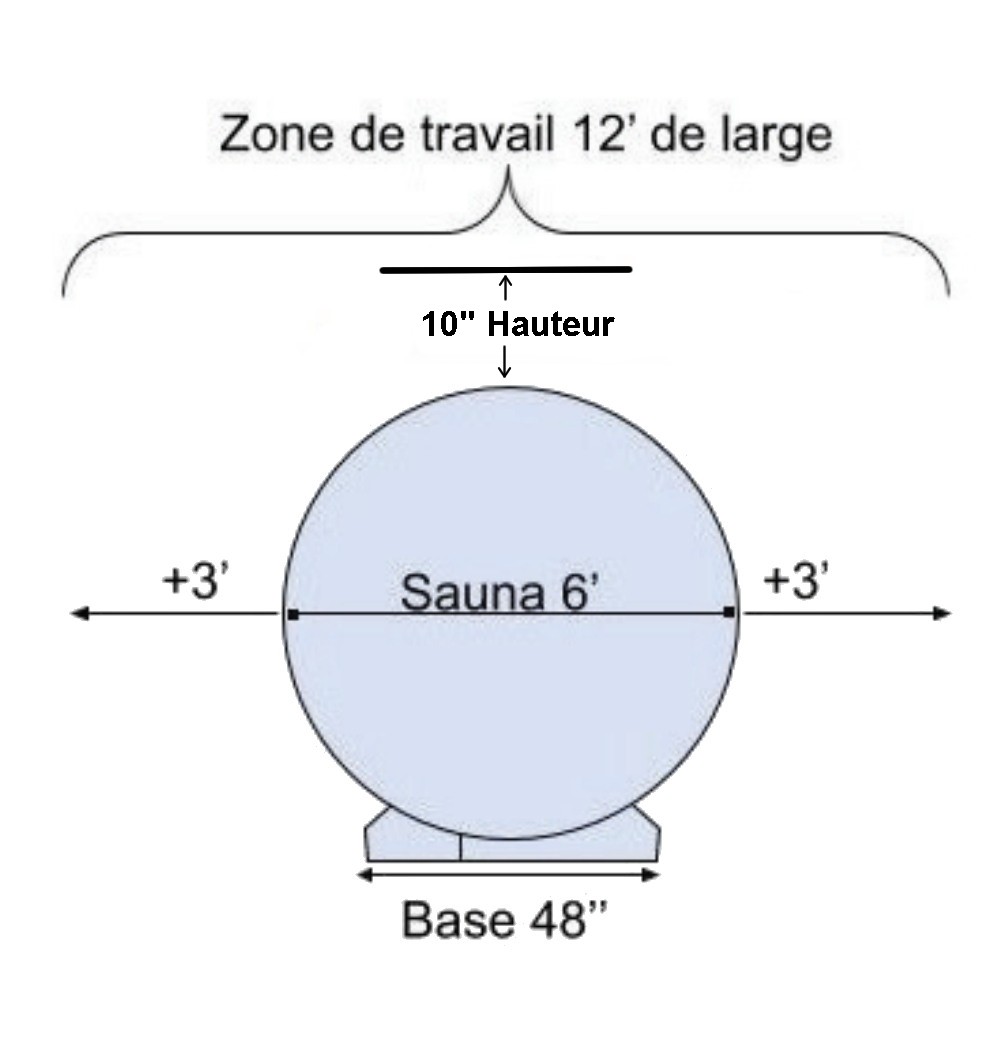
_____
Never operate the heater without any rocks!
Use only the rocks or stones which are supplied with the sauna heater. Wash the rocks with water before placing inside the heater, install rocks between and around heating elements. Do not force rocks between elements. Use smaller stones first, and continue to fill heater with larger stones until they just below the rock guard. You may not need all of the stones.
Stones should be placed loosely around the heating elements so to permit an easy air circulation. The rocks should completely cover the heating elements. Pouring water over exposed elements could cause damage, avoid any thermal choc to the heater elements!
First time use: with your sauna door open, exceptionally turn on your heater for (5) five minutes to allow the non-toxic protective coating on the heating elements to “burn off”. It is normal to see some light smoke as this coating burns off.
__________
This heater is operated using two dials – the thermostat and the timer.
Thermostat (left) controls the temperature of the sauna. Set it according to your personal preference.
Timer (right) turns the heater on and off, and has the ability to delay the start. If the heater has power, you should hear a loud “clunk” at both the 0 and the large 1. In between these “clunks” is one hour of heat time.
To immediately turn the heater on, you will need to turn the dial past the two clunks to number 1 or 2. Turn the timer back until one loud “clunk” is heard, immediately stopping the turn. This will begin the one hour of heat time. The heater will automatically shut off after one hour. You may have to redo this procedure if you want the sauna on for a longer period. The smaller numbers 1-8 refer to the number of hours for the delay start. For example, if you turn the timer to 5, your heater will begin heating in five hours for will be on for one hour.
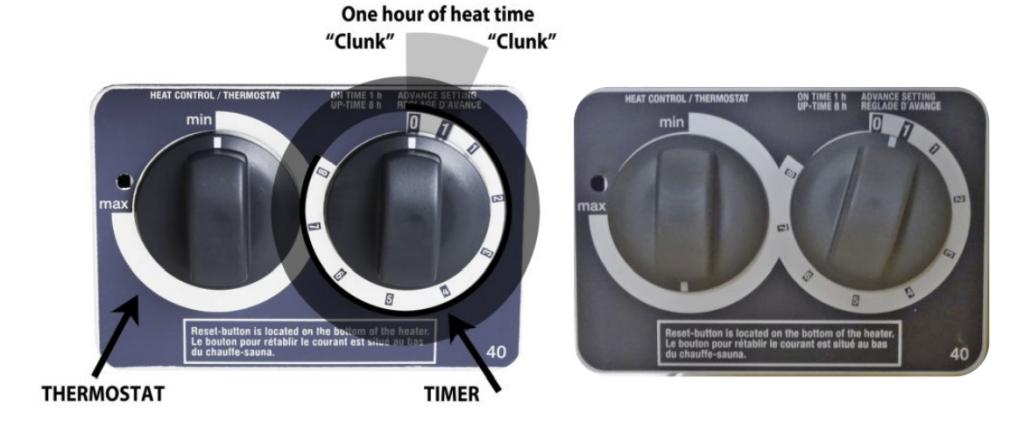
__________
If you have problems with the door not closing well, check if the sauna is leveled, this should fix the door problem, if the problem persists, you can plane the edge of the door with a jointer plane tool or adjust the hinges accordingly.
Cedar wood will expand when exposed to moisture and shrink when dry, this can have an impact on the door fit and this could change over time. This is not an Installation fault, it’s the nature of wood when exposed to the elements. After every use, it is recommended to leave the door slightly open to let any excess humidity or moisture out.
__________
Electric heating: Be careful not to put water on cold rocks. Always heat the stove and add only a ladle of clean water at a time, the water must evaporate immediately or you will damage the stove.
Always heat the stove before poring water on rocks, be mindful that the rocks should always be very hot and not cold before adding water. Add only a ladleful of clean water at a time. The water should evaporate immediately, otherwise you risk damaging the elements.
Only use clean water on the sauna stones, never use water from a SPA or swimming pool, as this will destroy your heater. Next, never directly on the elements, as this produces a thermal shock that will end up damaging one or more of the elements. You should provide enough rock to avoid any damage.
__________
Why use sauna rocks?
Due to their ability to both absorb and release heat, sauna rocks are essential to the sauna experience. Water vaporises and produces steam when it is poured over heated rocks, helping to raise the temperature and humidity. Traditional saunas frequently use sauna rocks as decorative accents to enhance the mood and appearance of the room.
How often should sauna rocks be replaced?
Depending on the frequency of use and the condition of the rocks, you should replace the sauna rocks every one to two years. It's essential to check your sauna stones if you see cracked pebbles beneath your heater or a drop in heat and steam. Each year, these stones should be examined, and any that are cracked or delicate should be replaced.
How are sauna rocks cleaned?
Make sure the rocks are cool and the sauna is turned off before beginning to clean the rocks. All rocks should be taken out of the heater, and any cracked or crumbly ones should be thrown away. After that, rinse them in water to remove any dirt and dust.
Will adding additional rocks increase sauna heat?
The sauna may get hotter by adding more rocks to the heater. However, the type of rocks also matters, and you should give your sauna enough time to fully warm up if you want to raise the temperature in it.
Can essential oils be applied to sauna rocks?
Avoid applying essential oils directly to the rocks in the sauna. Before pouring the water onto the rocks, you can add some essential oils, such as peppermint and eucalyptus, to the water. The inside of the sauna will smell amazing as a result!
Can rocks in a sauna explode?
If there is water trapped inside some rocks, such as natural river rocks, they may erupt or even break. When rocks are heated, the water inside them converts to steam, which increases internal pressure to the point of explosion. To avoid using natural rocks in your sauna, buy stones specifically made for the purpose.
__________
The maximum allowable sauna temperature in Canada and the United States is 90°C.
These are C.S.A. and U.L. standards adopted in the year 1982. At that time, it was also mandated that there must be a high-temperature limit switch within the sauna heater. The limit switch must shut down the heater under any abnormal operating condition and have a one-hour timer maximum on all residential sauna controls.
There is no right or wrong sauna temperature as everyone has a different comfort level, and taking into account other factors such as age, pre-existing medical conditions, and overall health.
__________
The answer is YES ABSOLUTELY for the Standard Barrel and especially the Panoramic Barrel.
The maximum allowable sauna temperature in Canada and the United States is 90°C.
These are C.S.A. and U.L. standards adopted in the year 1982. At that time, it was also mandated that there must be a high-temperature limit switch within the sauna heater. The limit switch must shut down the heater under any abnormal operating condition and have a one-hour timer maximum on all residential sauna controls.
So if the heater temperature sensor is not installed, there will be a risk of material deformation or melting.
The acrylic dome melting temperature is 160°C, however long-term exposed to lower temperatures, as low as 95°C can damage or deform the acrylic structure. We recommend to never leave the sauna heater unattended or without any supervision to avoid such damage.
The door, windows and dome are designed to withstand normal sauna temperatures of between 60°C and 90° Celsius Maximum.
Water will boil at 100°C, raising the temperature of the sauna in any way above this threshold creates a risk of material damage or deformation and is considered a misuse, this will not be covered under the guarantee.
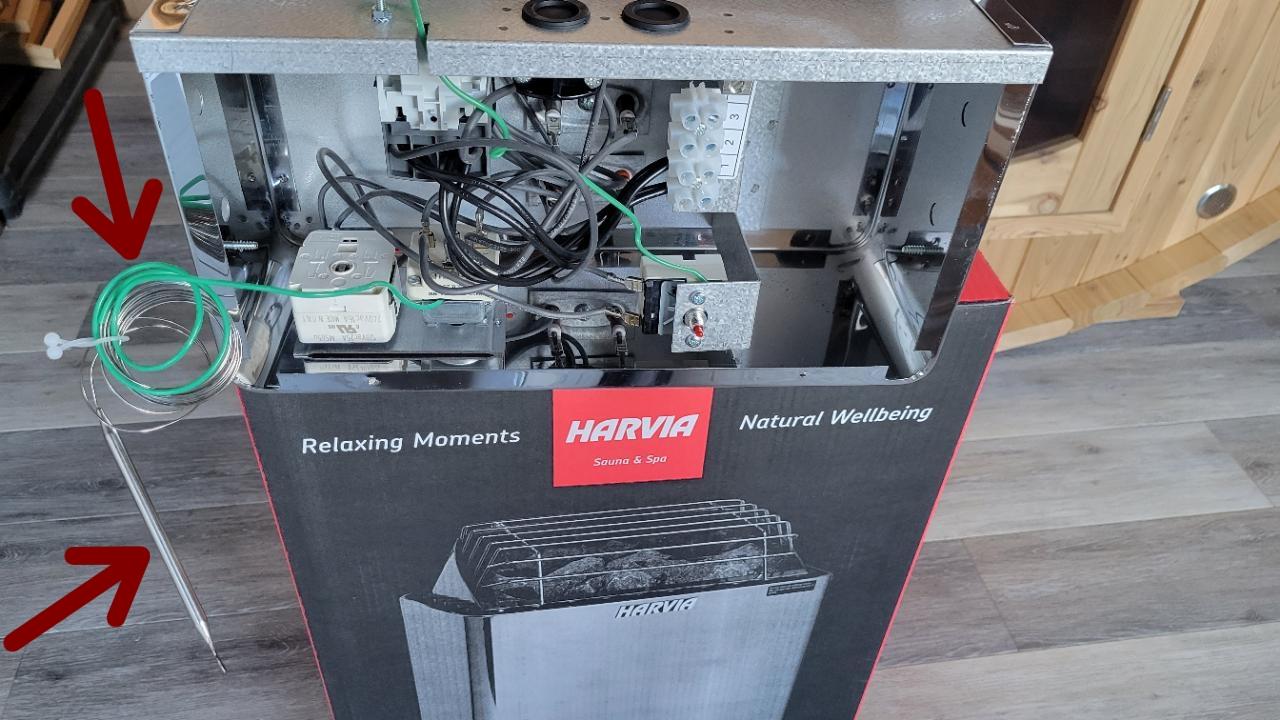
_____
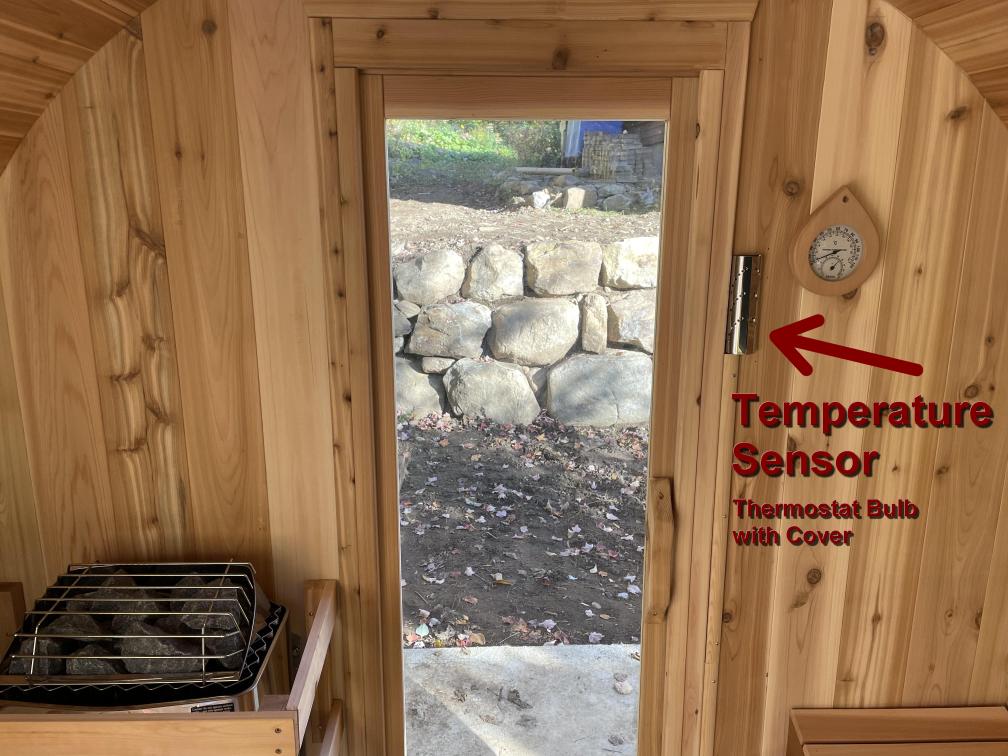
_____
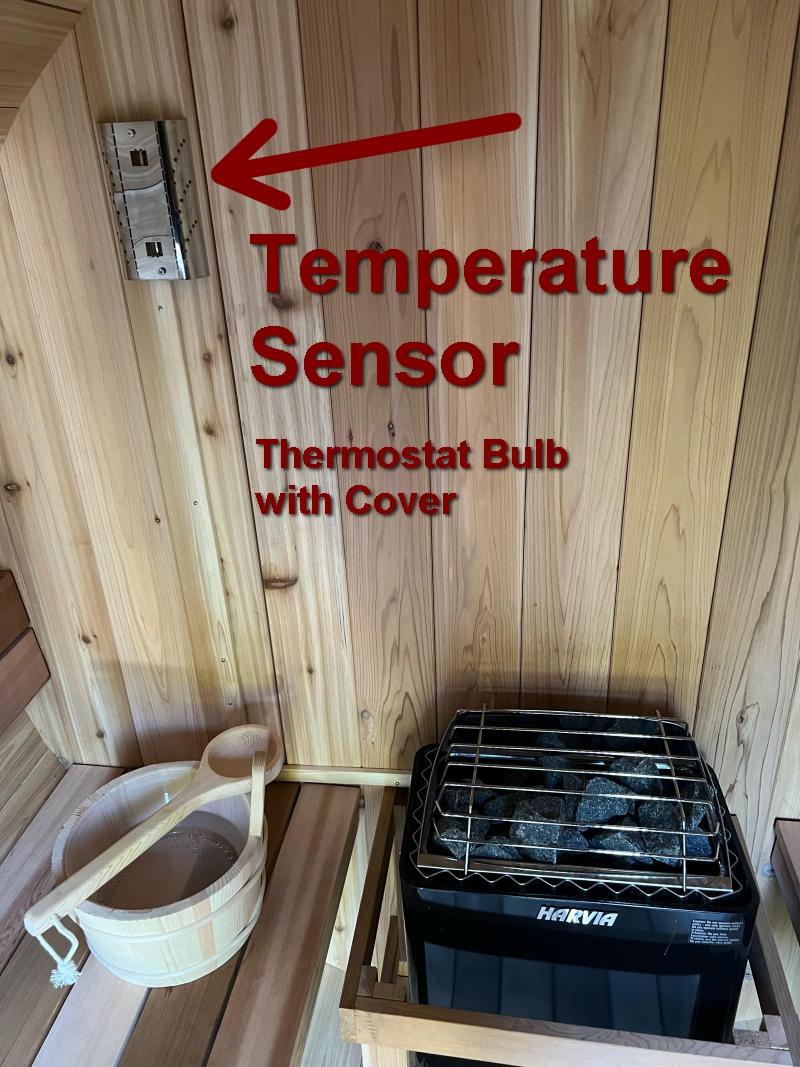
_____
__________
Electric KIP heaters from Harvia
The Harvia Heater that is provided with our saunas is a standard model. It is made of stainless steel, looks stunning, elegant, and most importantly, is easy to use. Consequently, this particular heater has two dials. The thermostat, which is the one on your left, is the first. The majority of users will keep it at the highest setting for the duration of the sauna. Your timer, which serves as both a on and an off switch, is located on the right. Your heater is heating when you hear the clunk. Once you get to "big number 1," make sure it clanks.
Your heater is currently heating up and operating. Keep turning the dial if you want to set a timer, and you'll hear a second clunk when your heater switches from on to pre-set mode and turns off. You may programme your heater to turn itself on up to 8 hours in advance using this feature! Your heater will count down and when it is ready to turn on, you will hear a clunk. Once the heater's predetermined duration has run out, it will continue to heat for 60 minutes, depending on the outside temperature, until it reaches its maximum temperature of 70°C to 90 °C.
How do I get my sauna hotter?
You want to heat up your barrel sauna as much as you can once you're powered up. How can I get my sauna hotter is one of the most frequent queries we receive from customers. The Harvia KIP Electric Heater is the standard heater that we offer. Your sauna should reach temperatures of 70°C, this also depends on the outside temperatures.
There are three key factors that will contribute to it not reaching that temperature.
1) The heater's height is the first consideration. The heater's base shouldn't be located more than five to seven inches from the sauna floor. If it's placed too high, it will only heat the area directly above the heater. It will heat more area if it is lower.
2) The arrangement of your stones is the second potential cause of your sauna's inability to reach the desired temperature. Each heater includes a box of rocks containing 20Kg or roughly 40 pounds of stones; you should only utilise about 3/4 to 7/8 of that box's contents. This implies that after setting the stones, you'll have five to ten extra stones. The reason is that if you fill your heater with too many stones, it will block airflow and reduce heat transfer.
3) The positioning of your temperature sensor is the third and most frequent cause of your sauna not reaching the desired temperature. Your Harvia Heater's temperature sensor is a security feature. In the event of overheating, it will turn off your heater. It should be already installed, if not, then when you remove the bottom plate from your heater, you'll find the temperature sensor coiled up with around five feet of wire. That temperature sensor should be mounted to the wall. You should leave at least 18 inches between the sensor and the ceiling and also 18 inches to the side of the heater. Of course, this is a rough estimate. We don't want to set it too high since heat rises; if we do, your heater may again sense a higher temperature than it actually is and turn itself off early.
Make sure to measure about six inches above the center horizontal support brace. That way it's not above the heater, nor is it too high, where it will sense unrealistic temperature.
__________
If you have moisture on the acrylic or polycarbonate window, it is because the air inside the barrel is too humid.
The barrel sauna is considered a DRY SAUNA.
a) Avoid exceeding 30% humidity inside the sauna.
b) Facilitate a good ventilation to let out any excess humidity, especially after your sauna session.
__________
Wood is a so-called “living” material: it reacts to its environment. It expands in moisture and shrinks when dried. Before using your sauna for the first time, it is recommended to turn on the sauna heater to an average heat level for a couple of hours.
Do not enter inside during this process. Let your sauna heat up to remove any humidity in the wood, then cool down on its own without adding water to the stones or any other intervention on your part. Following this treatment, tighten the straps nuts a few turns.
Within a month following its installation, your sauna can continue to move or work. This is normal. Tighten the nuts when necessary.
If necessary:
Tighten the nuts between seasons.
Maintain the exterior finish.
Clear snow or ice from the structure in winter.
1. Clean water should only be used on the sauna rocks. Never use spa or pool water as it will destroy your heater.
2. The sauna Bucket should always be used with clean water and remaining water should be dumped out after every use. Wash buckets and laddles occasionally when dirt collects from usage. Always use the plastic liner that is part of the bucket to prevent water leakage.
3. Good sanitation rules that each bather should sit or lie on a towel to keep inside clean and this will prolong bench life.
4. If the Sauna wood becomes stained from perspiration, use a damp cloth and wipe the wood in the same direction of the wood graine, for persistent stain, the wood may be lightly sanded with fine sandpaper to restore beautiful appearance. Do not apply any stains or sealers inside the sauna as toxic vapors may appear when heated.
5. Wipe the sauna heater occasionally with a damp cloth to maintain a beautiful appearance.
6. After approximately 5 years of usage, the rocks may need replacing if they have crumbled or powdered. Our Sauna Heaters require very little to no maintenance when installed properly by a qualified electrician.
__________
The main risks are linked to overuse leading to dehydration, or to people with blood pressure or heart problems.
Children should always be under the supervision of an adult.
Sauna use is known to be safe for anyone in good health.
People with medical problems should get their doctor’s approval before using a sauna. Using alcohol or drugs can interfere with your body’s ability to regulate its temperature. Excessive consumption combined with the use of a sauna can therefore pose a risk of severe hyperthermia which can lead to injury and/or death. It is therefore prohibited.
Stay tuned to your body.
__________
Sauna Safety 12 rules
1) Time spent inside the sauna
How long the human body can tolerate heat will vary from person to person. Average time is 15 to 20 minutes and is generally considered the maximum, for some, staying more than 30 minutes is acceptable. If, however you are sensitive to heat, start with a very short sauna session and see how you feel.
2) Cool Down moment
Finnish traditions are likely to go straight from the sauna and jump directly in very cold water or perhaps rolling in the snow. This could be hard to do for various people, we recommend to gradually cool down and enjoy the moment by taking a cool shower afterwards. Apparently by doing this temperature change, this helps your body removes any impurities that is transpired and prevents their reabsorption.
3) Resting time
You will need to relax for 10 minutes afterward. Give your body enough time to recuperate before doing back in the hot sauna. You could do this many times, hot cold, hot cold, however it is advised to limiting this to three times within a couple of hours.
4) Water rehydrates
Avoid and dehydration by drinking water before and after your sauna session. Eat something salty afterward is a good idea, that is, if you’ve sweat a lot.
5) Sauna sharing
In Finland, saunas are considered a social affair. Having a friend or family member is a good thing, so if a medical problem should occur, someone is there to help.
6) Metals
Any metal exposed to heat can burn, remove any or all jewelry before entering the sauna.
7) Consider your Health
Your heart will beat faster inside the sauna and it will work harder. This is a very good reason for people that suffer from any type of medical issues such as heart problems, pregnancy, high blood pressure to avoid going in the sauna. Always consult you doctor is you have any concerns.
8) Any use of chlorinated pool or spa water could damage the heating elements, only use clean water on the rocks.
9) Alcohol and the Sauna
Not a good idea, this could dehydrate your body and should be avoided.
10) Respect the heater
The sauna heater should not be used to dry clothes, swimsuits or towels, could be a fire risk to place any materials to close to the heater or fence guard.
11) Hot Saunas will Burn
Blistering can occur if to much time is spent in a hot sauna, if you notice your nose or skin is starting to sting, get out immediately. You will do you body a favour.
12) Monitor your reaction
Moderation is the best way to go, avoid the feeling of dizziness, nauseous or headaches by not over staying your sauna session.
__________
Unlike a pool, spa or hot tub, a sauna is only heated when it’s in use. This means that you are using electricity only for an hour or two per day at most. Even in areas where electric rates are rather high, regular use of a sauna will add only pennies per day to your utility bill. We also offer a wood burning sauna heater.
__________
We cannot accept COD orders. All orders must be paid in full prior to delivery.
__________
__________
Here are the sauna dimensions in PDF format for download:
- Standard Barrel 6x4 measurements
- Standard Barrel 6x5 measurements
- Standard Barrel 6x6 measurements
- Standard Barrel 6x7 measurements
- Standard Barrel 6x7 measurements with Porch
- Standard Barrel 6x8 measurements
- Standard Barrel 6x9 measurements
- Panoramic Barrel 6x4 measurements
- Panoramic Barrel 6x5 measurements
- Panoramic Barrel 6x6 measurements
- Panoramic Barrel 6x7 measurements
- Panoramic Barrel 6x7 sauna measurements with Porch
- Panoramic Barrel 6x8 measurements
- Panoramic Barrel 6x9 measurements
___
